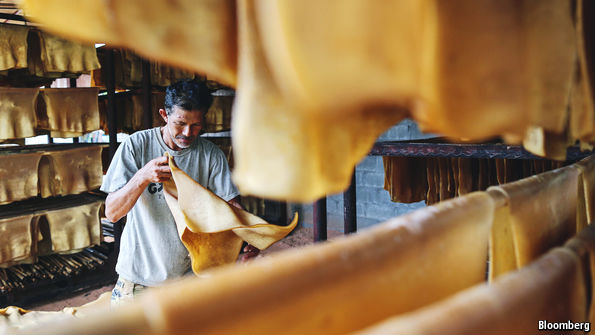YOU can make a good living buying a kilogram of rubber in the Ivory Coast for 50 cents and selling it in Singapore for $1.50. But you would need to buy 10m kilos to make the deal worthwhile. Traders who do not have the necessary $5m must borrow it. Before the financial crisis, big banks like BNP Paribas, Citigroup, HSBC and ING deployed $14 trillion a year on such deals. But new regulations and swingeing fines for serving shady customers, in addition to falling commodity prices, have caused that figure to halve, leaving a host of new lenders jockeying to fill the gap.
 The money that commodity producers borrow to help them dig, grow, store, transport or otherwise market their wares is vital to the global economy. But commodity trade finance, as it is known, is having to find new arteries. It is not that banks have lost lots of money in trade finance—far from it. The commodities being shifted serve as collateral for the loans used to buy them, limiting the scope for losses. Instead, the business has become an unintended victim of post-crisis regulation.
The money that commodity producers borrow to help them dig, grow, store, transport or otherwise market their wares is vital to the global economy. But commodity trade finance, as it is known, is having to find new arteries. It is not that banks have lost lots of money in trade finance—far from it. The commodities being shifted serve as collateral for the loans used to buy them, limiting the scope for losses. Instead, the business has become an unintended victim of post-crisis regulation.
A cap on leverage at banks has hit European lenders, the powerhouses of trade finance, particularly hard. With limits on how big their balance-sheets can grow, they are focusing on those activities that use up the least capital for the highest return. Returns on commodity trade finance, typically 6-8% a year, fall into the dispensable category. Nice add-ons like foreign-exchange fees help, but not enough.
Perhaps the biggest deterrents are the fines that banks have had to pay for abetting suspect transactions. BNP Paribas coughed up $9 billion last year after American regulators accused it of facilitating trade—much of it linked to commodities—in Sudan, Iran and Cuba, in contravention of American sanctions. The cost of vetting a new customer to ensure compliance with laws on money-laundering and finance for terrorism can reach $75,000.
Most banks with global operations are slowly but steadily deserting the farthest-flung bits of their empires. Larger clients are the priority now. Jean-François Lambert, the head of commodity trade finance at HSBC, says such retrenchment “is about making smart choices”.
That has left opportunities for others. American banks such as Citi, which tend to have less leveraged balance-sheets than European ones since they securitise and sell on most mortgages, are showing some interest. Dubai is trying to set itself up as a trade-finance hub, in competition with Switzerland, where European banks have tended to base trade-financing arms. But lenders in the Gulf are often too small to handle larger transactions.
Non-banks are also taking an interest, says Philip Prowse of Clyde & Co, a law firm. Institutional investors that prize safe and predictable investments, such as insurers and sovereign-wealth funds, have snapped up staff leaving banks. Specialist investment outfits are also hoping for a piece of the action. Scipion Capital, Barak Fund Management and BAF Capital are among those focused on underserved sectors such as fertiliser in Africa or juice concentrates in Latin America.
The new entrants are not subject to any limits on their lending, although they must observe the same “know your customer” rules as banks. But they claim their competitive advantage lies elsewhere. Leaner and more entrepreneurial than clunking multinational banks, the upstarts can meet tighter deadlines: where a big bank might take six months to approve a fertiliser shipment to an African country, Barak boasts it can arrange financing in three weeks.
Funds like these will account for perhaps $15 billion-20 billion of transactions around the world this year, a tiny but fast-growing slice of the market. Despite the dip in commodity prices and the slowdown in global trade, newly vacated niche markets offer lots of opportunity to prosper.
Banks are now more likely to lend to big commodity-trading houses, such as Vitol and Trafigura, which then go on to lend to their suppliers. That cuts risk, but also banks’ exposure to end-clients and the wider business they might provide. Fans of trade financing laud its “real-economy” element: bankers must take old-fashioned business risks rather than making abstract bets on the movements of arcane financial instruments. But much of the regulation heaped on since such arcane instruments sparked the financial crisis has crimped banking in the real economy.


























